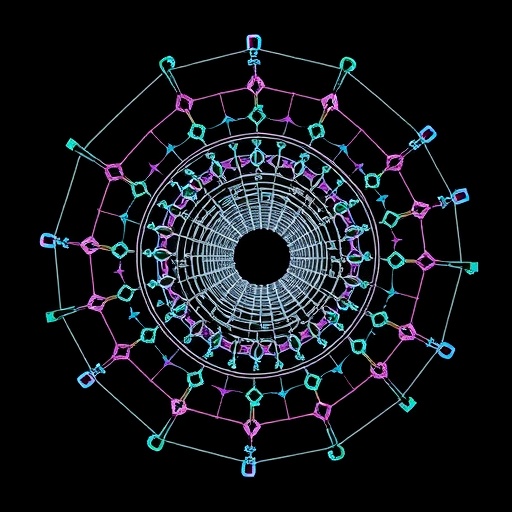
In a groundbreaking advancement in the realm of organic electronics, researchers have unveiled the exceptional photoconductive prowess of supramolecular complexes constructed from two perylene units. This discovery punctuates the evolving understanding of how carefully engineered molecular architectures can foster efficient charge transport, a cornerstone for next-generation optoelectronic devices. The focal point of this research is a novel compound, designated as F-spiro-NG, whose radical-ion characteristics appear to catalyze the generation of fully dissociated free charge carriers under external stimuli, heralding promising implications for technological innovation.
The exploration into the conductive pathways within F-spiro-NG was rigorously undertaken using differential photoconductivity measurements under direct current conditions. Utilizing microwave probes to monitor the localized dynamics of photo-injected charge carriers provided unprecedented granularity in understanding the intricate behaviors at play. When thin solid films of F-spiro-NG were exposed to tightly controlled pulses of ultraviolet light at 355 nanometers, charge movement within the material exhibited remarkable longevity and intensity, underscoring the material’s aptitude for sustaining conductive states. Such longevity in free charge carriers strongly correlates with improved performance prospects in devices relying on stable charge transport.
Parallel assessments with the related compound spiro-NG furnished valuable comparative insights. Both molecules manifested clear conductivity signals upon excitation; however, F-spiro-NG demonstrated a conductivity magnitude approximately three times greater than that of its predecessor. The maximum recorded conductivity for F-spiro-NG reached an impressive 3 × 10⁻⁷ m² V⁻¹ s⁻¹, a testament to its highly efficient charge mobility pathways. This enhancement is ascribed to the fundamental electronic structure modifications imparted by fluorination, which facilitates the stabilization of radical-ion states and expedites carrier movement through the molecular framework.
To quantify the mobility of these photo-injected charge carriers more precisely, transient absorption spectroscopy (TA) was employed. This technique allowed for real-time tracking of radical ion signatures, particularly at the wavelength of 430 nanometers. The spectra acquired aligned congruently with established electrochemical data delineating characteristic peaks of radical anions and cations formed via oxidation and reduction processes. Although discrepancies between the direct current conductivity measurements and TA kinetic traces were observed in the sub-microsecond domain, these were attributed primarily to the quenching influence of residual oxygen in the experimental environment, which affected the lifespan of nascent radical anions adversely.
A pivotal observation emerged at times beyond two microseconds, where both TA and differential photoconductivity traces exhibited close alignment, facilitating accurate estimations of intrinsic charge carrier mobility. By leveraging the known extinction coefficient of radical cations of F-spiro-NG, the researchers computed a quantum yield (ϕ⁺) of 5 × 10⁻⁴. This, in turn, yielded a mobility estimation (Σμ) of approximately 6 cm² V⁻¹ s⁻¹, a strikingly high figure for organic semiconductors and a clear indicator of the material’s potential viability for high-performance photoconductive applications.
The implications of these findings resonate beyond mere academic interest. Organic optoelectronic materials with such elevated charge carrier mobilities could revolutionize technologies ranging from solar energy harvesting to photodetectors and flexible electronic displays. The bilayer spironanographene structure, with its open-shell and zwitterionic attributes, represents a formidable platform for tailoring electronic features via molecular design. By exploiting radical-ion states stabilized within this framework, researchers have opened new avenues to surmount traditional limitations encountered in organic semiconductors.
Further structural analysis suggests that the spiro-linked bilayer configuration fosters spatial separation of charges, reducing recombination rates that typically diminish device efficiencies. The fluorinated variant, F-spiro-NG, benefits from electronic perturbations due to the electronegative substituents, effectively modulating frontier molecular orbitals to favor charge mobility and stabilize transient charges. This nuanced understanding of structure–property relationships is instrumental in guiding synthetic strategies targeting bespoke molecular systems optimized for specific electronic functions.
Interrogation of the photophysical responses under intense pulsed laser exposure revealed subtle dynamical processes influencing charge carrier generation and decay. The coexistence and temporal evolution of radical ions were captured with temporal resolution that demystified the interactions governing the longevity and transport of charges in solid-state films. Importantly, these studies consider real-world ambient conditions, underscoring the robustness of F-spiro-NG toward application environments which are rarely pristine or oxygen-free.
This research effort exemplifies the synergistic application of complementary techniques—microwave differential photoconductivity alongside transient absorption spectroscopy—to dissect complex photogenerated charge dynamics. Such methodological rigor provides a blueprint for future explorations within the field, emphasizing the need to concurrently address carrier generation, mobility, and recombination mechanisms for complete materials characterization. The high mobility values observed in F-spiro-NG challenge prevailing paradigms and hint at the unrealized potential embedded within carefully crafted open-shell organic systems.
Moreover, the study’s findings hold promise for the engineering of molecular electronic devices that require stable radical intermediates as active charge carriers. The unusually high mobility and prolonged lifetimes elevate F-spiro-NG beyond a mere academic curiosity, positioning it as a candidate for transistors and photovoltaic components where electron and hole transport efficiency is paramount. Harnessing open-shell molecules in such contexts further invites exploration into spintronic applications, where control over radical spins can influence device functionality in novel ways.
The emergent theme from this work highlights the power of molecular design in transcending inherent limitations of organic semiconductors. By integrating zwitterionic open-shell characteristics within bilayer spironanographenes, the researchers have demonstrated a versatile platform where electronic and structural parameters can be fine-tuned to elicit desired transport behaviors. This modularity paves the way for rational development of organic materials capable of rivaling inorganic counterparts on efficiency and stability metrics.
Importantly, this investigation adds to a growing body of knowledge emphasizing the crucial role of supramolecular interactions in dictating electronic properties. The supramolecular assembly of perylene units, modulated by fluorination and spiro linkage, orchestrates an environment where charge carriers experience extended delocalization and minimized traps. These collective behaviors underpin the enhanced photoconductivity and mobility outcomes, reinforcing the notion that molecular packing and aggregate morphology are integral to device performance.
Looking forward, research inspired by these findings is anticipated to delve deeper into the interplay between molecular structure, excited-state dynamics, and charge transport phenomena. Opportunities abound to explore systematic modifications to the spironanographene framework with alternative substituents, spin states, or layered arrangements, each offering pathways to tailor optoelectronic responses. Additionally, probing device architectures that incorporate F-spiro-NG films promises to validate and harness these promising intrinsic properties in functional settings.
In sum, the innovative work on F-spiro-NG elucidates compelling evidence that zwitterionic, open-shell bilayer spironanographenes are powerful candidates for next-generation organic photoconductors. Through meticulous experimentation combining differential photoconductivity and transient absorption spectroscopy, the material reveals exceptional charge mobility and radical ion persistence, hallmark traits critical for high-impact optoelectronic applications. This study not only elevates scientific understanding of radical-ion mediated conduction but also serves as a clarion call for the broader adoption of open-shell molecular architectures in practical device engineering.
Subject of Research: Synthesis and photoconductive properties of zwitterionic open-shell bilayer spironanographenes, focusing on charge carrier dynamics and mobility in novel fluorinated spiro-linked materials.
Article Title: Synthesis of zwitterionic open-shell bilayer spironanographenes.
Article References:
Lión-Villar, J., Fernández-García, J.M., Medina Rivero, S. et al. Synthesis of zwitterionic open-shell bilayer spironanographenes. Nat. Chem. (2025). https://doi.org/10.1038/s41557-025-01810-2
Image Credits: AI Generated
Tags: bilayer spiranonographenescharge carrier dynamicsconductive pathways in organic materialsdifferential photoconductivity measurementsefficient charge transport mechanismsopen-shell compoundsoptoelectronic device innovationorganic electronics advancementsphotoconductive properties of perylene unitssupramolecular complexes in electronicsultraviolet light stimulation in materialszwitterionic materials



